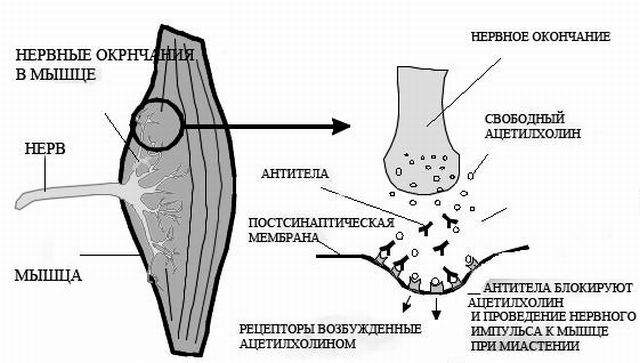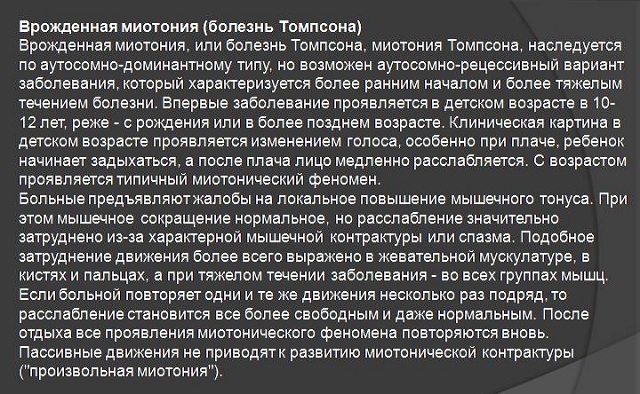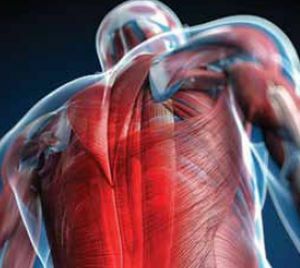 Myasthenic Lambert-Eaton syndrome is a disease characterized by muscle weakness and fatigue. The most difficult part is the muscles of the trunk and located in the proximal part of the lower extremities.
Myasthenic Lambert-Eaton syndrome is a disease characterized by muscle weakness and fatigue. The most difficult part is the muscles of the trunk and located in the proximal part of the lower extremities.
Muscle weakness is sometimes accompanied by soreness( myalgia).Muscles of the upper extremities and eyes with Lambert-Eaton syndrome suffer much less frequently than with myasthenia gravis.
Patients with this syndrome, when they are required to rise from a recumbent or sitting position, experience serious difficulties. To temporarily improve the activity of muscles helps their maximum short-term tension.
Very rare in this disease there is a pronounced weakness of the respiratory muscles, but sometimes it is the main sign of pathology, which helps to save the patient's life.
The disorder of the autonomic nervous system is noted in most people with Lambert-Eaton syndrome. Dysfunction can be suspected for the following symptoms:
- decrease in sweat and saliva;
- orthostatic hypotension;
- pupils cease to respond to light;
- in men develops impotence.
Many patients have weak or no deep tendon reflexes. But after a short-term strain of the muscles, these reflexes can briefly return.

Contents of
- Causes of the disease
- Clinical picture
- Diagnostic methods
- Treatment of Lambert-Eaton syndrome
- Other forms of myasthenia gravis
- Ptosis
- Myasthenia gravis
- Preventative measures
Causes of the development of the disease
Today there is still no definitive answer to the question what are the causes of myasthenic syndrome? Many scientists agree that the heredity factor plays a big role here. Collecting the data of the anamnesis, most often the doctor finds out that the patient has or had close relatives suffering from this pathology.
Often the course of the syndrome is accompanied by:
- hyperplasia or thymus tumor;
- by dermatomyositis;
- with amyotrophic lateral sclerosis;
- with oncological diseases of the lung, ovary or breast.
In such a situation, myasthenia gravis is not an independent disease, but a syndrome. Various adverse factors( poor immunity, frequent stresses, infectious diseases) provoke a healthy organism to produce antibodies to its own cells, under the influence of which the postsynaptic membrane is destroyed.
As a result, the impulse transmission is weakened, they gradually fade out altogether.

Clinical picture of
In patients with myasthenic Lambert-Eaton syndrome, the following symptoms are observed in the patient:
- rapid uncaused fatigue of muscles of different groups;
- late in the evening the patient notices double vision;

- visual acuity decreases;
- the descent of the upper eyelid occurs;
- voice becomes nasal, and diction loses clarity;
- is painful when swallowed;
- constipation and diarrhea;
- breathing dysfunction;
- tachycardia.
Cholinergic crisis also develops - a life-threatening condition requiring immediate hospitalization of the patient:
- a sharp reduction in the heart rate;
- pupillary narrowing;
- activation of intestinal peristalsis;
- increased involuntary salivation;
- high secretion of bronchial mucus.
Diagnostic methods
The diagnosis of Lambert-Eaton syndrome is based on a whole complex of measures.
The patient's subjective complaints are analyzed and an anamnesis is made. Here the following factors are taken into account:
- when the first signs appeared;
- whether there are problems with eyesight( double vision, eyelid depression);
- presence of rheumatoid arthritis;
- hereditary data.
Next, the doctor examines the patient and invites him to undergo diagnostic tests: a proserin test, a test with repeated movements.
Laboratory and hardware studies: 
- determination of the concentration of specific antibodies ;
- MRI and CT of the anterior mediastinum , using these techniques can detect a tumor of the thymus gland;
- electroneuromyography is an instrumental evaluation of the rate of passage of the nerve impulse and the degree of muscle excitability. If the patient has a myasthenic syndrome, the former remains normal, and the second indicator deviates.
Treatment of Lambert-Eaton syndrome
Lambert-Eaton syndrome is treated with anticholinesterase medications, as a rule, the doctor prescribes to the patient Prozerin, Oksazil, Galantamine or Kalimin.
In the treatment it is necessary to strictly observe the dosage of drugs, since an overdose of these medicines threatens with cholinergic intoxication resulting in:
- twitching, convulsions;
- bradycardia;
- during the course of saliva;
- pupillary narrowing;
- intestinal colic and spasms.
Therapy with these medicines is carried out for years. From time to time, it requires a dose adjustment or a drug change. To enhance the  effects of drugs, the patient is prescribed potassium salts. In severe cases, cytostatics and hormone therapy are used.
effects of drugs, the patient is prescribed potassium salts. In severe cases, cytostatics and hormone therapy are used.
A good effect can be achieved by pulse-therapy. This technique consists in the introduction into the body of large doses of hormones for a short time. Gradually reduce the dose. When diagnosing cancer of the thymus gland, the patient is prescribed an operation.
If the myasthenic crisis has severe symptoms, the patient is placed in the intensive care unit where he is ventilated, Immunoglobulin is injected, the blood is filtered using plasmapheresis.
Other forms of myasthenia gravis
There are the following forms of myasthenia gravis.
Ptosis
The patient doubles in the eyes, the movement of the eyeballs is limited, the eyelids do not completely close. These symptoms are caused by the defeat of the muscles responsible for the movement of the eye and raising the eyelids.
Based on these symptoms, the diagnosis of myasthenia gravis is possible in the early stages of development. The eyes are most often affected asymmetrically, that is, one at a time, and the eyelids can be struck simultaneously( left and right).
The visual defect, as a rule, disappears after a long rest and appears again under eye strain.
Myasthenia gravis
Generalized myasthenia gravis is characterized by the defeat of the entire muscular system. The first signs of the disease:
- slight lethargy and weakness in muscles, disappearing after rest;
- arms and legs become heavy and stop obeying;
- possible signs of myasthenia gravis;
- heart rate change;
- increased salivation.

To identify the disease can be analyzed by anamnesis of the patient and by a comprehensive examination. Typical periods of crises and remission are typical for the generalized myasthenia gravis.
If a patient has a crisis( it is determined by the symptoms described above), the ambulance team should be called immediately.
Before the arrival of physicians, the patient needs to provide good access to fresh air, complete rest, give drinks to reduce blood pressure.
Preventative measures
The main prevention of myasthenia gravis is a healthy lifestyle. As statistics show, the development of the disease affects the weight of a person, and this can be obesity and excessive leanness. 
Each person's diet should be rich in vitamins and trace elements, the lack of these substances can provoke the disease.
If the patient has a genetic predisposition, he must correctly plan physical activities, as muscle overload can be extremely negative for them. However, it is also impossible to completely exclude physical exercises. For a good metabolism, tissues need a warm-up.
Myasthenia gravis, as it relates to autoimmune diseases, can easily develop in a person with poor immunity. Therefore, strengthening the immune system is an important link in the prevention package. Good immunity, if not prevent the disease, will soften its symptoms and reduce the risk of relapse.



